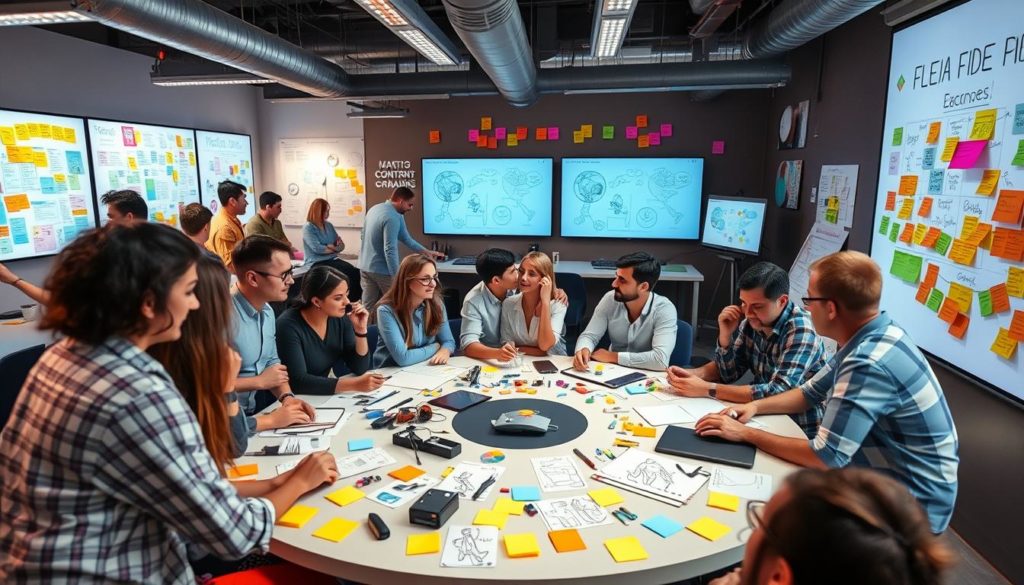
Did you know companies with innovation labs are three times more likely to create breakthrough products? This fact shows how powerful spaces for creative experimentation and disruptive technologies can be. The Rockefeller Foundation’s projects show how big goals can lead to big changes, like making sustainable fishing work in Peru.
We use the Stanford ChangeLabs method to boost creativity and solve problems. By encouraging a ‘yes, and’ way of thinking, we make sure ideas grow and work well together. Labs teach us how to brainstorm, map systems, and make quick prototypes. Thanks to experts like John B. Thomas, these labs help us change not just tech, but also how we work and make things sustainable.
Key Takeaways
- Innovation labs are key for making new products.
- Creative testing can change systems for the better.
- The ‘yes, and’ way helps make better solutions.
- Tools like brainstorming and quick prototypes help people create.
- Experts and teamwork push forward new strategies and digital changes.
The Purpose of Innovation Labs
Innovation labs are key in boosting creativity and solving user problems. They mix research and development with technology advancements. This creates a place where collaborative innovation can grow. Companies like Google and Amazon show how to use innovation labs well.
Fostering Disruptive Thinking
Innovation labs aim to encourage disruptive thinking. They challenge the usual ways and bring new ideas. Google’s X lab, for example, has started projects like Project Loon and Waymo. These show how pushing limits can lead to big innovations.
Driving Customer-centric Solutions
Innovation labs focus on making products that meet user needs. They look at what users struggle with and create better products. Apple uses their labs to improve user experiences and make products that really help their customers. This makes sure the products are useful and focused on the user.
Accelerating Time-to-Market
Innovation labs work to get new products out faster. They use agile development to quickly make prototypes and launch products. Amazon’s Lab126 is a great example of this. They can quickly turn ideas into products that many people use, showing the power of agile development.
The goal of innovation labs is to blend research and development with real insights. This makes sure new technologies are not just advanced but also useful and competitive. By promoting collaborative innovation, they help companies stay ahead in a fast-changing market.
Creating a Collaborative Environment
To build a true team, we need more than just working together. We must have managers who make sure everyone is involved and leads together. This way, everyone feels part of the team.
Encouraging Cross-Disciplinary Collaboration
IBM Garage shows how mixing different skills leads to big ideas. They bring together people from various fields to create things like IBM Food Trust. This mixing skills helps share knowledge and keeps everyone working towards the same goals. This makes the team work better together.
Promoting Intrapreneurship
Encouraging intrapreneurship is key to growing a business. Tools like Adobe’s KICKBOX help bring out this spirit. By letting employees innovate, companies can use their creativity to stay ahead and do better.
Providing Safe Spaces for Risk-taking
Places where it’s safe to take risks are vital for new ideas. Google X, known as the “moonshot factory,” shows how embracing failure can lead to learning. This safety lets everyone share their ideas, making innovation open to all.
It’s important to have good feedback and accountability to help the team work together well. For managers, it’s key to set clear goals and show the value of working together. This helps bring out the best in everyone.
| Attribute | Collaboration | Cooperation |
|---|---|---|
| Interaction Level | High | Moderate |
| Shared Leadership | Yes | No |
| Engagement | Active | Passive |
Implementing Behavioral Motivations in Innovation Labs
In today’s fast-paced world, knowing behavioral motivations is key. By understanding what drives people, we can make a space where creativity grows and obstacles disappear.
Understanding Self-direction
Self-direction is crucial in innovation labs. When people have the power to make choices, they want to solve problems more. Daniel Pink’s work shows that giving teams the freedom to follow their ideas boosts creativity. This way, everyone feels important and heard, making the team more productive.
Reducing Institutional Hierarchy
Making innovation labs less hierarchical is vital for a fair and open space. Places like the Rockefeller Foundation show how dropping barriers helps ideas flow freely. Without fear of being judged, people can freely explore and share their ideas. This leads to more innovative solutions.
Using strategies that support self-direction and reduce hierarchy follows behavioral science. These methods boost innovation chances and make creativity a key part of the work environment.
Real-world Examples of Successful Innovation Labs
Google X Moonshot Factory is a name that stands out in the world of innovation. It works on big projects that go beyond what we have today. They’re working on things like self-driving cars and internet from balloons. This shows how creative ideas can become real with the right support.
Google X: Moonshot Factory
Google X is a key player in innovation labs. It focuses on big projects to solve big problems. By taking big risks, they’ve made huge leaps forward. This shows how important it is to support bold ideas in innovation labs.
Amazon Lab126: Rapid Prototyping
Amazon Lab126 is known for quickly turning ideas into products. They’ve brought us the Kindle and Echo, among others. Their success shows how a focused innovation lab can bring new products to the market fast.
IBM Garage: Design Thinking Workshops
IBM Garage is all about design thinking and working together. They use these methods to make better solutions. By focusing on what users need, they make sure their innovations are practical and useful.
These examples show how important it is to have the right structure and methods for innovation. For more information, check out this detailed article.
FAQ
What are innovation labs and how do they contribute to creative experimentation?
Innovation labs are places where new ideas and digital changes happen. They let people test and improve forward-thinking ideas. This leads to new solutions. By using tools like brainstorming, labs help teams work together and be creative.
How do innovation labs support research and development?
Innovation labs are key in research and development. They offer a space for teams to try out new ideas and tech. This lets them make quick changes and improve their work.
Through working together, labs speed up the release of new products. This means new tech gets used faster.
What is the significance of cross-disciplinary collaboration in innovation labs?
Having different people from various fields work together in innovation labs is crucial. It brings together many ideas and perspectives. This leads to solutions that think about users and solve big problems.
By working together, labs like IBM Garage create big impacts. They use a mix of skills and teamwork to make new solutions.
How do innovation labs promote intrapreneurship?
Innovation labs help people grow new ideas within a company. Tools like KICKBOX give employees the chance to work on their projects. This leads to growth and new ideas from inside the company.
This keeps companies ahead by always changing and adapting to new things.
Why is providing safe spaces for risk-taking important in innovation labs?
Safe spaces for trying new things are key in innovation labs. They let people learn and grow by trying out new ideas. Places like Google X focus on being safe, so people can share their ideas freely.
This creates a place where creativity and trying new things is encouraged. It leads to big changes.
How do innovation labs implement behavioral motivations to foster creativity?
Innovation labs use ideas from Daniel Pink to boost creativity. They focus on letting everyone be creative and giving them the tools to explore. This way, everyone’s ideas are valued, leading to new solutions.
Can you provide examples of successful innovation labs?
Yes! Google X, Amazon Lab126, and IBM Garage are great examples. Google X works on big projects like self-driving cars and internet from balloons. Amazon Lab126 quickly makes and launches new products like Kindle and Echo.
IBM Garage uses design thinking to make solutions that focus on users. This leads to things like the IBM Food Trust.
Future App Studios is an award-winning software development & outsourcing company. Our team of experts is ready to craft the solution your company needs.










